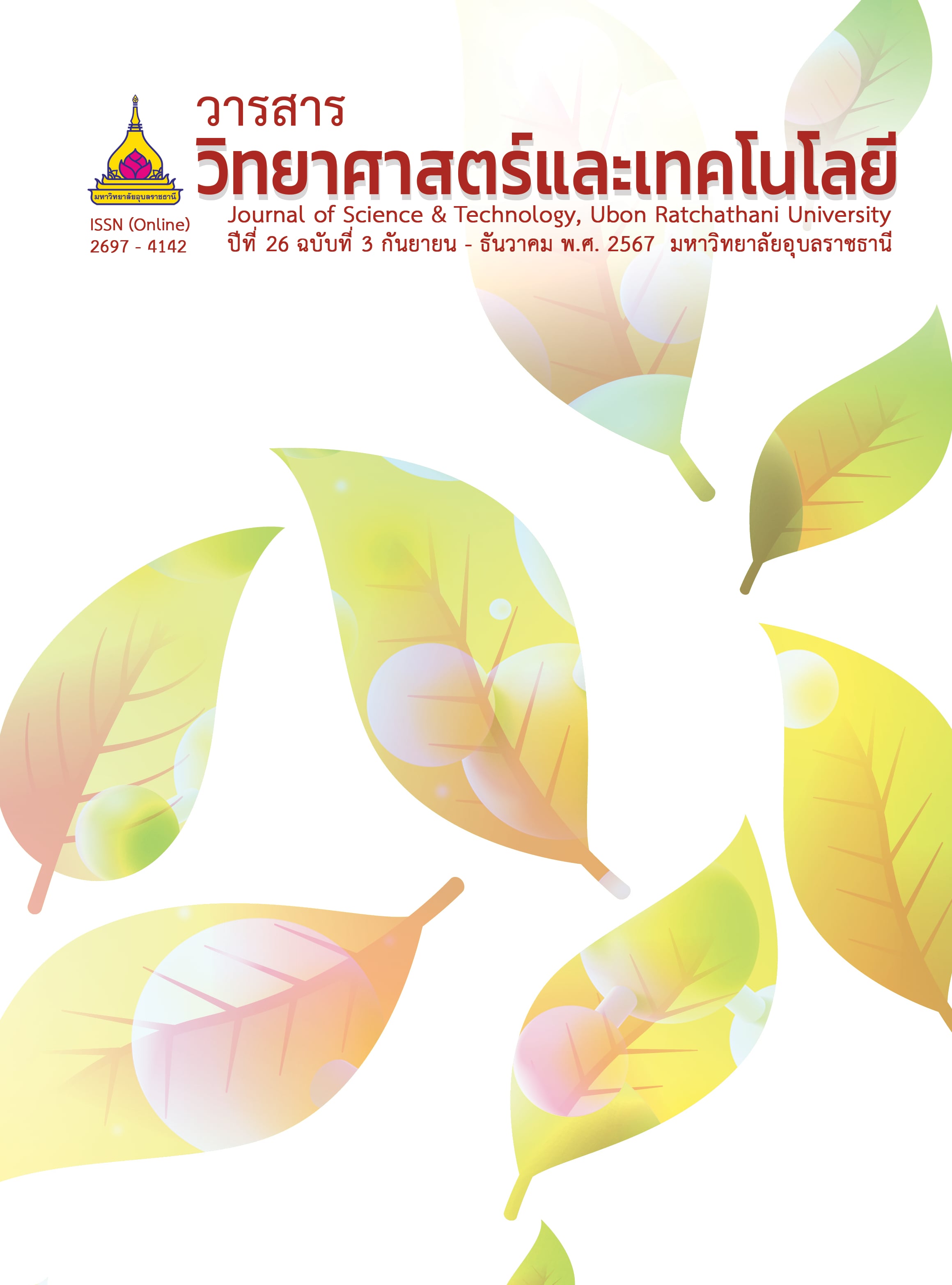คุณสมบัติต้านอนุมูลอิสระ ปริมาณสารประกอบฟีนอลิกทั้งหมด และคุณสมบัติพรีไบโอติก ของเห็ดนมเสือ (Lignosus rhinocerus (Cooke) Ryvarden)
Main Article Content
บทคัดย่อ
งานวิจัยนี้มีวัตถุประสงค์เพื่อศึกษาคุณสมบัติต้านอนุมูลอิสระ ปริมาณสารประกอบฟีนอลิกทั้งหมด และคุณสมบัติพรีไบโอติกของเห็ดนมเสือ (Lignosus rhinocerus (Cooke) Ryvarden)) ที่มีอายุ 2, 3, 4, 5 และ 6 เดือน การเตรียมตัวอย่างเห็ดนมเสือทำโดยบดให้เป็นผง แล้วนำไปสกัดด้วย 80% เอทานอล เพื่อให้ได้สารสกัดเห็ดที่มีความเข้มข้น 5, 25, 50, 75 และ 100 ไมโครลิตรต่อมิลลิลิตร จากนั้นนำสารสกัดเห็ดดังกล่าวไปตรวจสอบคุณสมบัติต้านอนุมูลอิสระ และปริมาณสารประกอบฟีนอลิกทั้งหมด การตรวจสอบคุณสมบัติต้านอนุมูลอิสระใช้วิธี DPPH radical scavenging assay และการวิเคราะห์ปริมาณสารประกอบฟีนอลิกทั้งหมดใช้วิธี Folin-Ciocalteu’s method ส่วนการตรวจสอบคุณสมบัติพรีไบโอติกใช้การประเมินความสามารถของผงเห็ดนมเสือในการส่งเสริม การเจริญของแบคทีเรียกลุ่มโพรไบโอติก ซึ่งในการศึกษานี้ใช้ Lactobacillus casei TISTR 1463 และ L. plantarum TISTR 1465 ผลการศึกษา พบว่า ในแต่ละช่วงอายุของเห็ด คุณสมบัติต้านอนุมูลอิสระ และปริมาณสารประกอบฟีนอลิกทั้งหมดเพิ่มขึ้นตามความเข้มข้นของสารสกัดเห็ดที่เพิ่มขึ้น อย่างไรก็ตามอายุของเห็ดมีผลต่อคุณสมบัติต้านอนุมูลอิสระ และปริมาณสารประกอบฟีนอลิกทั้งหมดของ เห็ดนมเสือ โดยสารสกัดจากเห็ดนมเสือที่มีอายุ 2, 3 และ 4 เดือน ที่ความเข้มข้นเท่ากับ 100 ไมโครลิตรต่อมิลลิลิตร มีคุณสมบัติ ต้านอนุมูลอิสระดีที่สุด และปริมาณสารประกอบฟีนอลิกมากที่สุด และต่างจากสารสกัดจากเห็ดนมเสือที่มีอายุ 5 และ 6 เดือน ที่ ความเข้มข้นเท่ากับ 100 ไมโครลิตรต่อมิลลิลิตรอย่างมีนัยสำคัญทางสถิติ นอกจากนี้ยังพบว่าอายุของเห็ดมีผลต่อคุณสมบัติพรีไบโอติกของเห็ดนมเสือด้วย โดยผงเห็ดนมเสือที่เตรียมจากเห็ดนมเสือที่มีอายุ 2, 3 และ 4 เดือนมีความสามารถในการส่งเสริมการเจริญของ L. casei TISTR 1463 และ L. plantarum TISTR 1465 ได้ดีกว่าผงเห็ดนมเสือที่เตรียมจากเห็ดนมเสือที่มีอายุ 6 เดือนอย่างมีนัยสำคัญทางสถิติ งานวิจัยนี้แสดงให้เห็นว่าเห็ดนมเสือมีคุณสมบัติต้านอนุมูลอิสระและพรีไบโอติกที่อาจมีประโยชน์ต่อการนำไปประยุกต์ใช้ต่อไป
Article Details

อนุญาตภายใต้เงื่อนไข Creative Commons Attribution-NonCommercial-NoDerivatives 4.0 International License.
บทความที่ได้รับการตีพิมพ์เป็นลิขสิทธิ์ของ วารสารวิทยาศาสตร์และเทคโนโลยี มหาวิทยาลัยอุบลราชธานี
ข้อความที่ปรากฏในบทความแต่ละเรื่องในวารสารวิชาการเล่มนี้เป็นความคิดเห็นส่วนตัวของผู้เขียนแต่ละท่านไม่เกี่ยวข้องกับมหาวิทยาลัยอุบลราชธานี และคณาจารย์ท่านอื่นๆในมหาวิทยาลัยฯ แต่อย่างใด ความรับผิดชอบองค์ประกอบทั้งหมดของบทความแต่ละเรื่องเป็นของผู้เขียนแต่ละท่าน หากมีความผิดพลาดใดๆ ผู้เขียนแต่ละท่านจะรับผิดชอบบทความของตนเองแต่ผู้เดียว
เอกสารอ้างอิง
Nallathamby, N. and et al. 2018. A status review of the bioactive activities of tiger milk mushroom Lignosus rhinocerotis (Cooke) Ryvarden. Frontiers in Pharmacology. 8: 998.
Tan, E.S.S., Leo, T.K. and Tan, C.K. 2021. Effect of tiger milk mushroom (Lignosus rhinocerus) supplementation on respiratory health, immunity and antioxidant status: an open-label prospective study. Scientific Reports. 11: 11781.
Johnathan, M. and et al. 2016. Phytochemical profiles and inhibitory effects of tiger milk mushroom (Lignosus rhinocerus) extract on ovalbumin-induced airway inflammation in a rodent model of asthma. BMC Complementary and Alternative Medicine. 16: 167.
Soontharapirakkul, K. and Kotpat, T. 2022. Development of Soil Cultivation of Medicinal Mushrooms (Lignosus rhinocerus) to Stimulate the Growth and Biological Activity of Tiger Milk Mushroom Sclerotia. Research Report, King Mongkut's University of Technology Thonburi. (in Thai)
Wansutha, S. and Yunyaw, L. 2018. Antioxidant properties of probiotics. Journal of Traditional Thai Medical Research. 4(1): 1-19. (in Thai)
Martemucci, G. and et al. 2022. Free radical properties, source and targets, antioxidant consumption and health. Oxygen. 2(2): 48-78
Dehghanian, Z. and et al. 2022. Reinforcing the bulwark: unravelling the efficient applications of plant phenolics and tannins against environmental stresses. Heliyon. 8(3): e09094.
Kumar, N. and Goel, N. 2019. Phenolic acids: Natural versatile molecules with promising therapeutic applications. Biotechnology Reports. 24: e00370.
Bamigbade, G.B. and et al. 2022. An updated review on prebiotics: Insights on potentials of food seeds waste as source of potential prebiotics. Molecules. 27(18): 5947.
You, S. and et al. 2022. The promotion mechanism of prebiotics for probiotics: A review. Frontiers in Nutrition. 9: 1000517.
Al-Sheraji, S.H. and et al. 2013. Prebiotics as functional foods: A review. Journal of Functional Foods. 5(4): 1542-1553.
Inyod, T. and et al. 2022. Antioxidant activities and prebiotic properties of the tropical mushroom Macrocybe crassa. Bioactive Carbohydrates and Dietary Fibre. 27: 100298.
Fernandes, A. and et al. 2023. Exploring mushroom polysaccharides for the development of novel prebiotics: A review. International Journal of Medicinal Mushrooms. 25(2): 1-10.
Seephonkai, P. and et al. 2011. DPPH radical scavenging activity and total phenolics of Phellinus mushroom extracts collected from northeast of Thailand. Chinese Journal of Natural Medicines. 9(6): 441-445.
Baschieri, A. and et al. 2017. Explaining the antioxidant activity of some common non-phenolic components of essential oils. Food Chemistry. 232: 656-663.
Alispahic, A. and et al. 2015. Phenolic content and antioxidant activity of mushroom extracts from Bosnian market. Bulletin of the Chemists and Technologists of Bosnia and Herzegovina. 44: 5-8.
Sharpe, E. and et al. 2021. Comparison of antioxidant activity and extraction techniques for commercially and laboratory prepared extracts from six mushroom species. Journal of Agriculture and Food Research. 4: 100130.
Sengkhamparn, N. and Phonkerd, N. 2014. Effects of heat treatment on free radical scavenging capacities and phenolic compounds in Tylopilus alboater wild edible mushrooms. Chiang Mai Journal of Science. 41: 1241-1249.
Rattana, T. and Sangsanga, T. 2016. Antioxidant and prebiotic properties of Sakaerat wild edible mushrooms. Thai Science and Technology Journal. 24(4): 538-550. (in Thai)
Tachalerdmanee, P. and et al. 2016. Effect of total phenolic content on free radical scavenging activities of Boletes mushroom extracts. Thai Journal of Pharmaceutical Sciences. 40: 88-91.
Kaewnarin, K. and et al. 2016. Phenolic profile of various wild edible mushroom extracts from Thailand and their antioxidant properties, anti-tyrosinase and hyperglycaemic inhibitory activities. Journal of Functional Foods. 27: 352-364.


